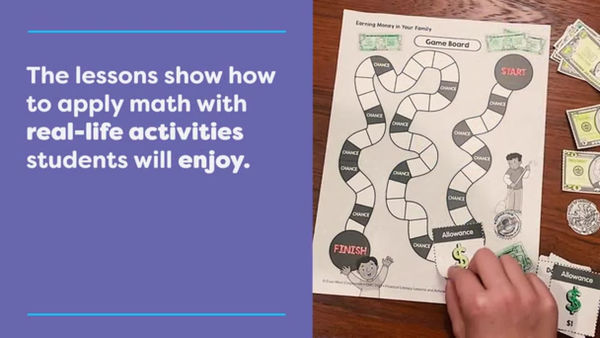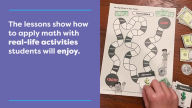
Financial Literacy Lessons and Activities, Grade 4 Teacher Resource
144
Financial Literacy Lessons and Activities, Grade 4 Teacher Resource
144Paperback
-
PICK UP IN STORECheck Availability at Nearby Stores
Available within 2 business hours
Related collections and offers
Overview
This dynamic teaching resource provides reproducible cut-out math manipulatives, reference sheets, and visual aids to support students as they explore real-world lessons and hands-on activities related to paying bills, earning money at a job, using banks, paying for health services, buying things at a store, and more.
Financial Literacy Lessons and Activities for Grade 4 is based on national and state standards and enriches any math curriculum in the classroom or home.
What’s Inside
Financial Literacy Lessons and Activities Grade 4 is based on current national and state standards, and each of the 10 units includes:
- Teacher overview with a suggested teaching plan, discussion questions, and vocabulary
- Real-world story that introduces each unit’s theme in the context of real life
- Cross-curricular activities including vocabulary, reading comprehension, and social studies
- Math application that presents scenarios using money-based word problems
- Hands-on activities such as partner and whole-class games and role playing that bring the concepts to life
Valuable teaching tools include these reproducible worksheets:
- Cut-out math manipulatives such as play money
- Reference sheets and visual aids such as number charts and balance sheets
- Glossary of vocabulary words
144 reproducible pages. Includes answer key.
This is a reproducible resource (photocopying of lessons is permitted) for single classroom or individual home use only.
About Evan-Moor A leader in PreK–8 educational publishing, Evan-Moor has been a trusted partner of teachers and parents for over 40 years. Our mission is helping children learn, and we do this by creating resources that motivate children to learn important skills and concepts across the curriculum while also inspiring a love of learning.

Product Details
| ISBN-13: | 9781645142683 |
|---|---|
| Publisher: | Evan-Moor Corporation |
| Publication date: | 01/01/2023 |
| Series: | Financial Literacy Lessons & Activities |
| Pages: | 144 |
| Product dimensions: | 8.50(w) x 11.00(h) x 0.37(d) |
| Age Range: | 9 - 10 Years |
About the Author
Table of Contents
What's in Financial Literacy Lessons and Activities 6
How to Use Financial Literacy Lessons and Activities 9
Reproducible Student Resource/Reference Pages
Play Money Cutouts 10
Multiply to 100 Table 11
How to Add and Subtract Decimals 12
Balance Sheet 13
Number Lines 14
Vocabulary Definitions 15
Units
Buying at the Store 18
Financial Concepts: All choices have an "opportunity cost": the options you don't choose.
Buyers prioritize or rank what they want.
Buyers should consider cost vs. benefit (is it worth what you're paying?).
Math Skills: addition, subtraction, multiplication, division, currency
Earning Money at a Job 30
Financial Concepts: Different jobs require different skills.
Employers pay what they think the skills are worth.
Math Skills: addition, subtraction, multiplication, division, graphs, currency
Making and Following a Budget 42
Financial Concepts: A budget is a plan for earning and spending money.
Income must always be at least as high as expenses.
Math Skills: addition, subtraction, multiplication, division, fractions, currency
Using Banks 54
Financial Concepts: Individual people and businesses have their own accounts at banks.
Banks have many services, including savings accounts, checking accounts, and lending money.
Banks charge money for their services.
Math Skills: addition, subtraction, multiplication, currency
Raising Money to Help Others 66
Financial Concepts: When people or communities experience hardship, their needs may not be met.
Some valuable public services may not have adequate funding.
People and organizations raise money to help those in need.
Math Skills: addition, subtraction, multiplication, currency
Planning a Party 78
Financial Concepts: Celebrations and get-togethers often involve buying goods and services.
Decisions made about goods and services involve many features that need to be ranked.
Goods and services need to be appropriate for the type of party.
Math Skills: addition, subtraction, multiplication, currency
Starting a Business 90
Financial Concepts: Starting a business takes effort and planning.
The business owner pays employees and pays for all resources needed.
The business owner keeps all the money that is left over.
Math Skills: addition, subtraction, multiplication, currency
Paying Bills 102
Financial Concepts: There are many recurring costs involved in running a household.
We pay for services that provide power, water, and communication.
We pay for ongoing subscriptions, lessons, and memberships.
Math Skills: addition, subtraction, multiplication, division, currency
Using Credit Cards 114
Financial Concepts: Credit is a promj.se to pay for goods and services later.
Credit cards allow delayed payment for a short or long time.
The longer you take to pay, the more you pay.
Math Skills: addition, subtraction, multiplication, currency
Paying for Health Services 126
Financial Concepts: We pay for healthcare workers, medicines, and medical treatments.
Some services, including public health, are paid for by governments.
Many people buy insurance to lower the cost of healthcare.
Math Skills: addition, subtraction, multiplication, division, currency
Answer Key 138
Related Subjects
Videos















